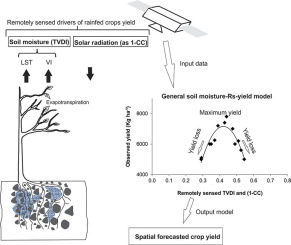ISPRS Journal of Photogrammetry and Remote Sensing ( IF 12.7 ) Pub Date : 2018-03-20 , DOI: 10.1016/j.isprsjprs.2018.03.014 Mauro E. Holzman , Facundo Carmona , Raúl Rivas , Raquel Niclòs

|
Soil moisture (SM) available for evapotranspiration is crucial for food security, given the significant interannual yield variability of rainfed crops in large agricultural regions. Also, incoming solar radiation (Rs) influences the photosynthetic rate of vegetated surfaces and can affect productivity. The aim of this work is to evaluate the ability of crop water stress and Rs remotely sensed data to forecast yield at regional scale. Temperature Vegetation Dryness Index (TVDI) was computed as an indicator of crop water stress and soil moisture availability. TVDI during critical growth stage of crops was calculated from MODIS products: MODIS/AQUA 8-day composite LST at 1 km and 16-day composite vegetation index at 1 km. Rs data were obtained from Clouds and the Earth’s Radiant Energy System (CERES). The relationship between TVDI, Rs and yield of wheat, corn and soybean was analyzed. High R2 values (0.55–0.82, depending on crop and region) were found in different agro-climatic regions of Argentine Pampas. Validation results showed the suitability of the model RMSE = 330–1300 kg ha−1, Relative Error = 13–34%. However, results were significantly improved considering the most important factor affecting yield. Rs proved to be important for winter crops in humid areas, where incoming radiation can be a limiting factor. In semi-arid regions, soils with low water retention capacity and summer crops, crop water stress showed the best results. Overall, results reflected that the proposed approach is suitable for crop yield forecasting at regional scale several weeks previous to harvest.
中文翻译:

通过遥感水分胁迫和太阳辐射数据对作物产量进行早期评估
鉴于大农业地区雨养作物的年际单产有很大的变化,可用于蒸散的土壤水分(SM)对于粮食安全至关重要。而且,入射的太阳辐射(Rs)影响植被表面的光合速率,并可能影响生产力。这项工作的目的是评估作物水分胁迫和Rs遥感数据在区域范围内预测产量的能力。计算了温度植被干燥指数(TVDI),作为作物水分胁迫和土壤水分供应的指标。作物关键生长阶段的TVDI由MODIS产品计算得出:MODIS / AQUA在1 km处的8天复合LST和在1 km处的16天复合植被指数。Rs数据是从云和地球辐射能系统(CERES)获得的。TVDI之间的关系,分析了小麦,玉米和大豆的卢比和单产。高R在阿根廷南美大草原的不同农业气候地区发现了2个值(0.55-0.82,取决于作物和地区)。验证结果表明该模型的适用性RMSE = 330–1300 kg ha -1,相对误差= 13–34%。但是,考虑到影响产量的最重要因素,结果得到了显着改善。事实证明,Rs对于潮湿地区的冬季农作物很重要,在这些地区,进入的辐射可能是一个限制因素。在半干旱地区,保水能力低的土壤和夏季作物,作物水分胁迫表现出最好的效果。总体而言,结果表明,提出的方法适合于收获前几周在区域范围内预测作物产量。



























 京公网安备 11010802027423号
京公网安备 11010802027423号